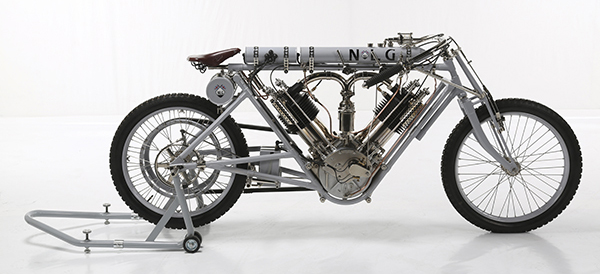 The ‘Beast of Brooklands’
The ‘Beast of Brooklands’ Lives Again
By Pavel Malanik, Luhacovice, Czech Republic
Nestled in the hills near the Slovak border in the far east of the Czech Republic is a village called Luhacovice. For years, unknown to us, a certain Pavel Malanik had been diligently toiling away on a project of breath-taking audacity, craftsmanship and beauty.
First seeing his ‘Beast of Brooklands’ as he wheeled it in on set-up day at the 2018 ‘AMD’ was one of those jaw dropping World Championship moments that come around every now and again - a moment when the brain just can’t fully process what the eyes are seeing.
His ‘Beast of Brooklands’ is an homage to a 1908 racer built not far from the legendary JA Prestwich factory (JAP) in north London by the gentlemen of an enterprise known, unsurprisingly, as North London Garage (NLG).
In 1905 JAP had built an 88 mm stroke 1,034 cc V-twin that raced in the 1906 International Cup in Austria.
JAP used that engine as a basis for three 120 mm stroke 2,714 cc engines that went to various owners, one being used by Matchless for a bike that never made it into volume production, one being used in a cycle car and the third being raced (unsuccessfully) at the 1908 Isle of Man TT. That is believed to be the JAP engine that eventually found its way to the Forster brothers at NLG.
The engine had apparently been too powerful for the single loop frames of the day, and Will Cook built a much stronger twin-loop cradle and did much else to it besides before, weighing about 113 kg (250 lb) and took it to Brooklands to have a crack at Henri Cissac’s flying-start kilometre and mile motorcycle world speed records set at the Brighton Speed Trials in 1905.
The NLG proved to be a beast on the banked circuit. It had no brakes and no suspension, and with the bike constantly trying to climb the concrete banking, Cook was hardly ever able to stay in the saddle at speeds above 70 mph, which is how its nickname came into being some years later.
Although Cook was never able to break Cissac’s records, he did post 26.553 seconds for the kilometre (84.247 mph) to set a new unlimited Brooklands track record, but not a world speed record. On a return visit to Brooklands later in 1908, unofficial stopwatch timing said he averaged over 90 mph.
The bike was subsequently displayed by NLG at the Stanley Show in London in 1908, but after further cracks at the record in 1910 the Forster brothers disposed of the bike and it subsequently disappeared from the record, along with the two other engines - ultimately no trace was left of the JAP 2,714 cc 80 degree JAP V-twin or ‘The Beast of Brooklands’ itself.
Fast forward 110 years and Pavel Malanik rolls his replica into the AMD World Championship at INTERMOT Customized in Cologne, Germany, and jaws dropped and grown men drooled!
Two years ago Malanik took his handcrafted replica to the famous banking of the Montlhery circuit in France, and on the 1.5:1 ratio that proved to be Cook’s glass ceiling it produced 100 kph/62 mph at 1,000 rpm and a top speed of 160 kph/100 mph on 3.00 x 21 inch Avons.

As Classic Bike magazine reported, Pavel Malanik is “the master of lost masterpieces”. He has previous form when it comes to recreating legendary motorcycles and he puts an incredible amount of time and effort into it.
A prior project was the inline four-cylinder Laurin & Klement CCCC, of which only four examples were ever made, with no survivors. “So he scaled up the only two period photographs in existence and researched the engine’s construction. A toolmaker specializing in press tools for the automotive industry, Pavel spent approximately 2,500 hours in his home to create that replica.
“His next project was the 1909 Torpedo, a semi-radial in-line V4 Torpedo racer with a capacity of 1,640 cc and a top speed in excess of 120 kph.” The one-off original of that bike had disappeared too.
As with his previous creations, Pavel thoroughly researched the NLG-JAP and used period photographs to make scale drawings. “To make the crankcases, he machined them from a block of alloy using his lathe, milling machine and a rotary table so that the 80° angle between the cylinders would be perfect.
“He bored right through a block of alloy so that the main shaft bearings would be in line, roughly machined the main external shape, and cut the alloy block in half along the vertical line. Then he milled out the timing chest and bored holes for the cam wheel shafts, tappet blocks and engine bolts. He machined the conrods from billet steel and made the cams, followers and gear wheels.
“Pavel fabricated frame lugs and bent the frame tubes to shape before pinning and brazing them together. He also made the forks, carburetor and ignition system, and spun the V-belt rim from sheet steel.”
Our thanks to Phillip Tooth whose Classic Bike feature on Pavel’s labor of love helped inform the history and detail that was ‘lost in translation’ when I spoke with Pavel at the AMD World Championship last October.













